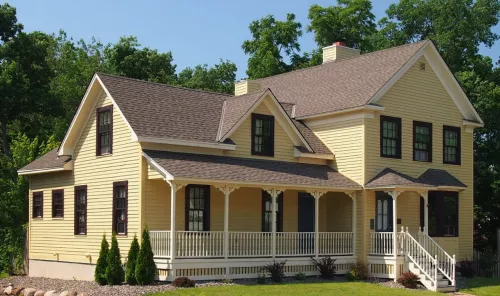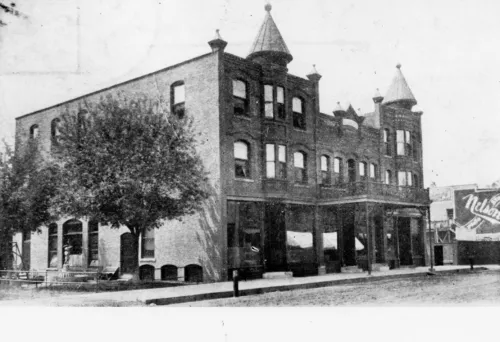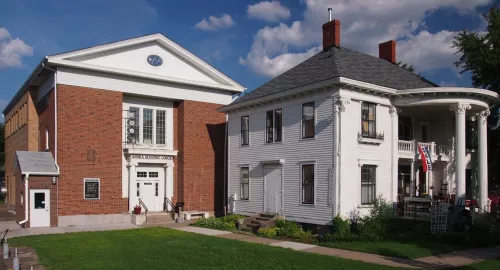Share what you know,
and discover more.
Share what you know,
and discover more.
Jun 30, 2013

-

- Charmaine Bantugan
Shaw-Hammons House
The Shaw–Hammons House, also known as the DeGraff–Follrath House, is the oldest standing residential building in Anoka, Minnesota, United States. It was originally built around 1852 and then expanded in 1870.[3] The Shaw–Hammons House was listed on the National Register of Historic Places in 1979 for its local significance in the themes of architecture and exploration/settlement.[4] It was nominated for its association with local Euro-American settlement through its succession of notable early owners, and for being Anoka's best-preserved example of Greek Revival architecture. Origin In 1854, Neil Shaw purchased and platted 160 acres (65 ha) of land in present-day Anoka County, Minnesota, with his three sons. They built the family home out of simple wood and clapboard siding while using elements of Greek Revival architecture in the formal design. Crowned with a slightly pitched roof, the eaves feature a detailed classical cornice. The eave returns, shuttered front windows, and entrance also embody the symmetry and grace of this style. Shaw used the east section of his house as one of Anoka's original storefronts from the 1850s into the 1870s. Afterward, ownership of the property changed hands many times. One of Anoka's prominent citizens, a transplanted attorney from Maine named Weston Hammons, purchased the home in 1870. That same year, Hammons added to the west section, creating a two-and-a-half-story structure with a full basement, which came to be considered the main house. Additional modifications involved remodeling the front façade—including the veranda—with turned posts and decorative spandrel. The interior of this section contains two parlors and a closet on the first floor, as well as two bedrooms, two closets, and a bath on the second floor. Hammons later expanded his business interests into the local lumber industry and to Anoka's Boot and Shoe Manufacturing Company, which endured as one of Anoka's most significant enterprises during the 1880s. Later history In 1883, Justice W. DeGraff, a railroad contractor and engineer, purchased the house for his wife and daughter. His only child, Marie, soon developed a keen interest in gardening and flowers. When she inherited the home from her parents, she expanded the property's garden. Under her care, the south side of the narrow lot along the house became a prolific producer of brightly colored flowers and plants, many of which Marie bred herself. To supplement her income, Marie gave piano lessons to the local children and was recognized as an accomplished artist. When Marie moved to a senior care facility in 1965, the house changed hands once again, this time to Darwin Follrath and his wife. The couple restored the home to its original 1870 configuration, and on February 11, 1980, the home received an official listing on the National Register of Historic Places. After the Follraths sold the home to a development company, it fell into disrepair. The developers considered it too far gone to restore and attempted to demolish it in order to make way for a condominium, though city zoning and preservation ordinances prohibited it. With those plans effectively cancelled and the home listed on the "most endangered" list compiled by the Preservation Alliance of Minnesota, the developers sold the home to a private citizen whose time, money, and efforts eventually revived it to its original 1870 luster.
Shaw-Hammons House
The Shaw–Hammons House, also known as the DeGraff–Follrath House, is the oldest standing residential building in Anoka, Minnesota, United States. It was originally built around 1852 and then expanded in 1870.[3] The Shaw–Hammons House was listed on the National Register of Historic Places in 1979 for its local significance in the themes of architecture and exploration/settlement.[4] It was nominated for its association with local Euro-American settlement through its succession of notable early owners, and for being Anoka's best-preserved example of Greek Revival architecture. Origin In 1854, Neil Shaw purchased and platted 160 acres (65 ha) of land in present-day Anoka County, Minnesota, with his three sons. They built the family home out of simple wood and clapboard siding while using elements of Greek Revival architecture in the formal design. Crowned with a slightly pitched roof, the eaves feature a detailed classical cornice. The eave returns, shuttered front windows, and entrance also embody the symmetry and grace of this style. Shaw used the east section of his house as one of Anoka's original storefronts from the 1850s into the 1870s. Afterward, ownership of the property changed hands many times. One of Anoka's prominent citizens, a transplanted attorney from Maine named Weston Hammons, purchased the home in 1870. That same year, Hammons added to the west section, creating a two-and-a-half-story structure with a full basement, which came to be considered the main house. Additional modifications involved remodeling the front façade—including the veranda—with turned posts and decorative spandrel. The interior of this section contains two parlors and a closet on the first floor, as well as two bedrooms, two closets, and a bath on the second floor. Hammons later expanded his business interests into the local lumber industry and to Anoka's Boot and Shoe Manufacturing Company, which endured as one of Anoka's most significant enterprises during the 1880s. Later history In 1883, Justice W. DeGraff, a railroad contractor and engineer, purchased the house for his wife and daughter. His only child, Marie, soon developed a keen interest in gardening and flowers. When she inherited the home from her parents, she expanded the property's garden. Under her care, the south side of the narrow lot along the house became a prolific producer of brightly colored flowers and plants, many of which Marie bred herself. To supplement her income, Marie gave piano lessons to the local children and was recognized as an accomplished artist. When Marie moved to a senior care facility in 1965, the house changed hands once again, this time to Darwin Follrath and his wife. The couple restored the home to its original 1870 configuration, and on February 11, 1980, the home received an official listing on the National Register of Historic Places. After the Follraths sold the home to a development company, it fell into disrepair. The developers considered it too far gone to restore and attempted to demolish it in order to make way for a condominium, though city zoning and preservation ordinances prohibited it. With those plans effectively cancelled and the home listed on the "most endangered" list compiled by the Preservation Alliance of Minnesota, the developers sold the home to a private citizen whose time, money, and efforts eventually revived it to its original 1870 luster.
Jun 30, 2013
Shaw-Hammons House
The Shaw–Hammons House, also known as the DeGraff–Follrath House, is the oldest standing residential building in Anoka, Minnesota, United States.It was originally built around 1852 and then expanded in 1870.[3] The Shaw–Hammons House was listed on the National Register of Historic Places in 1979 for its local significance in the themes of architecture and exploration/settlement.[4] It was nominated for its association with local Euro-American settlement through its succession of notable early owners, and for being Anoka's best-preserved example of Greek Revival architecture.
Origin
In 1854, Neil Shaw purchased and platted 160 acres (65 ha) of land in present-day Anoka County, Minnesota, with his three sons. They built the family home out of simple wood and clapboard siding while using elements of Greek Revival architecture in the formal design. Crowned with a slightly pitched roof, the eaves feature a detailed classical cornice. The eave returns, shuttered front windows, and entrance also embody the symmetry and grace of this style.
Shaw used the east section of his house as one of Anoka's original storefronts from the 1850s into the 1870s. Afterward, ownership of the property changed hands many times. One of Anoka's prominent citizens, a transplanted attorney from Maine named Weston Hammons, purchased the home in 1870. That same year, Hammons added to the west section, creating a two-and-a-half-story structure with a full basement, which came to be considered the main house. Additional modifications involved remodeling the front façade—including the veranda—with turned posts and decorative spandrel. The interior of this section contains two parlors and a closet on the first floor, as well as two bedrooms, two closets, and a bath on the second floor. Hammons later expanded his business interests into the local lumber industry and to Anoka's Boot and Shoe Manufacturing Company, which endured as one of Anoka's most significant enterprises during the 1880s.
Later history
In 1883, Justice W. DeGraff, a railroad contractor and engineer, purchased the house for his wife and daughter. His only child, Marie, soon developed a keen interest in gardening and flowers. When she inherited the home from her parents, she expanded the property's garden. Under her care, the south side of the narrow lot along the house became a prolific producer of brightly colored flowers and plants, many of which Marie bred herself. To supplement her income, Marie gave piano lessons to the local children and was recognized as an accomplished artist.
When Marie moved to a senior care facility in 1965, the house changed hands once again, this time to Darwin Follrath and his wife. The couple restored the home to its original 1870 configuration, and on February 11, 1980, the home received an official listing on the National Register of Historic Places.
After the Follraths sold the home to a development company, it fell into disrepair. The developers considered it too far gone to restore and attempted to demolish it in order to make way for a condominium, though city zoning and preservation ordinances prohibited it. With those plans effectively cancelled and the home listed on the "most endangered" list compiled by the Preservation Alliance of Minnesota, the developers sold the home to a private citizen whose time, money, and efforts eventually revived it to its original 1870 luster.
Posted Date
Jul 07, 2022
Historical Record Date
Jun 30, 2013
Source Name
Wikipedia
Source Website
Delete Story
Are you sure you want to delete this story?
Dec 26, 1979
Dec 26, 1979

-

- Charmaine Bantugan
National Register of Historic Places - Shaw-Hammons House
Statement of Significance: The Shaw-Hammons House is significant primarily for its historic association with Anoka's settlement. The historic figures who built or lived in this house represent a wide range of people who contributed to Anoka's history in a variety of ways. Architecturally, the house represents Anoka's best-preserved example of the Greek Revival style -- the city and county's most prevalent historic architectural style. The abstract of title to this house reads like a "who's who" of early St. Anthony (Minneapolis), St. Paul, and Anoka lumbermen, financiers, land speculators, bankers. and politicians. Between 1852 and 1860, the property was held by Antoine Robert, Henry Rice, Samuel Shaw, Neal Shaw, William Woodbury, and Sumner Farnham, among others; all these men figured prominently in the development of mid and late nineteenth century Minnesota. The east section of this house was built for use as a store and house by the Shaw family. The store was located along the eastern half of the first story. The Shaw store was moved in 1854 into the first building in Anoka to be constructed for a store. The Shaw family, originally from Maine, platted a 160-acre tract of land, "Shaw's Addition to Anoka," in 1854. In addition, the Shaw family was among the first proprietors of the dam and mills at Anoka. The east section of the house passed through several hands throughout the 1860s, In the spring of 1870, Weston Hammons, an attorney from Maine, constructed the two- and one-half story section of the house and remodeled the front facade of the original house, Hammons owned interests in several lumbering concerns located along the Rum and St. Croix Rivers. He served, for several years, as attorney for Anoka County. Hammons was among the incorporators of the Anoka Boot and Shoe Manufacturing Company, one of Anoka's largest industrial concerns in the 1880s. In 1883 Justus W. DeGraff, a railroad contractor and bridge engineer from Stearns County, Minnesota, purchased the house from Weston Hammons. Prior to moving to Anoka, DeGraff had been a partner, with Nicholas DeGraff and William Crooks, in the firm of DeGraff and Company. This noted railroad building company constructed railroads in Minnesota and Iowa. The DeGraff family owned the house until 1965. In 1965 Marie DeGraff, Justus' daughter, a locally prominent educator and artist, sold the house to the Follraths. The Follraths restored the house, which had deteriorated greatly, to its 1870 appearance.
National Register of Historic Places - Shaw-Hammons House
Statement of Significance: The Shaw-Hammons House is significant primarily for its historic association with Anoka's settlement. The historic figures who built or lived in this house represent a wide range of people who contributed to Anoka's history in a variety of ways. Architecturally, the house represents Anoka's best-preserved example of the Greek Revival style -- the city and county's most prevalent historic architectural style. The abstract of title to this house reads like a "who's who" of early St. Anthony (Minneapolis), St. Paul, and Anoka lumbermen, financiers, land speculators, bankers. and politicians. Between 1852 and 1860, the property was held by Antoine Robert, Henry Rice, Samuel Shaw, Neal Shaw, William Woodbury, and Sumner Farnham, among others; all these men figured prominently in the development of mid and late nineteenth century Minnesota. The east section of this house was built for use as a store and house by the Shaw family. The store was located along the eastern half of the first story. The Shaw store was moved in 1854 into the first building in Anoka to be constructed for a store. The Shaw family, originally from Maine, platted a 160-acre tract of land, "Shaw's Addition to Anoka," in 1854. In addition, the Shaw family was among the first proprietors of the dam and mills at Anoka. The east section of the house passed through several hands throughout the 1860s, In the spring of 1870, Weston Hammons, an attorney from Maine, constructed the two- and one-half story section of the house and remodeled the front facade of the original house, Hammons owned interests in several lumbering concerns located along the Rum and St. Croix Rivers. He served, for several years, as attorney for Anoka County. Hammons was among the incorporators of the Anoka Boot and Shoe Manufacturing Company, one of Anoka's largest industrial concerns in the 1880s. In 1883 Justus W. DeGraff, a railroad contractor and bridge engineer from Stearns County, Minnesota, purchased the house from Weston Hammons. Prior to moving to Anoka, DeGraff had been a partner, with Nicholas DeGraff and William Crooks, in the firm of DeGraff and Company. This noted railroad building company constructed railroads in Minnesota and Iowa. The DeGraff family owned the house until 1965. In 1965 Marie DeGraff, Justus' daughter, a locally prominent educator and artist, sold the house to the Follraths. The Follraths restored the house, which had deteriorated greatly, to its 1870 appearance.
National Register of Historic Places - Shaw-Hammons House
Statement of Significance:The Shaw-Hammons House is significant primarily for its historic association with Anoka's settlement. The historic figures who built or lived in this house represent a wide range of people who contributed to Anoka's history in a variety of ways. Architecturally, the house represents Anoka's best-preserved example of the Greek Revival style -- the city and county's most prevalent historic architectural style.
The abstract of title to this house reads like a "who's who" of early St. Anthony (Minneapolis), St. Paul, and Anoka lumbermen, financiers, land speculators, bankers. and politicians. Between 1852 and 1860, the property was held by Antoine Robert, Henry Rice, Samuel Shaw, Neal Shaw, William Woodbury, and Sumner Farnham, among others; all these men figured prominently in the development of mid and late nineteenth century Minnesota.
The east section of this house was built for use as a store and house by the Shaw family. The store was located along the eastern half of the first story. The Shaw store was moved in 1854 into the first building in Anoka to be constructed for a store. The Shaw family, originally from Maine, platted a 160-acre tract of land, "Shaw's Addition to Anoka," in 1854. In addition, the Shaw family was among the first proprietors of the dam and mills at Anoka.
The east section of the house passed through several hands throughout the 1860s, In the spring of 1870, Weston Hammons, an attorney from Maine, constructed the two- and one-half story section of the house and remodeled the front facade of the original house, Hammons owned interests in several lumbering concerns located along the Rum and St. Croix Rivers. He served, for several years, as attorney for Anoka County. Hammons was among the incorporators of the Anoka Boot and Shoe Manufacturing Company, one of Anoka's largest industrial concerns in the 1880s.
In 1883 Justus W. DeGraff, a railroad contractor and bridge engineer from Stearns County, Minnesota, purchased the house from Weston Hammons. Prior to moving to Anoka, DeGraff had been a partner, with Nicholas DeGraff and William Crooks, in the firm of DeGraff and Company. This noted railroad building company constructed railroads in Minnesota and Iowa. The DeGraff family owned the house until 1965. In 1965 Marie DeGraff, Justus' daughter, a locally prominent educator and artist, sold the house to the Follraths.
The Follraths restored the house, which had deteriorated greatly, to its 1870 appearance.
Posted Date
Jul 07, 2022
Historical Record Date
Dec 26, 1979
Source Name
National Register of Historic Places
Source Website
Delete Story
Are you sure you want to delete this story?












